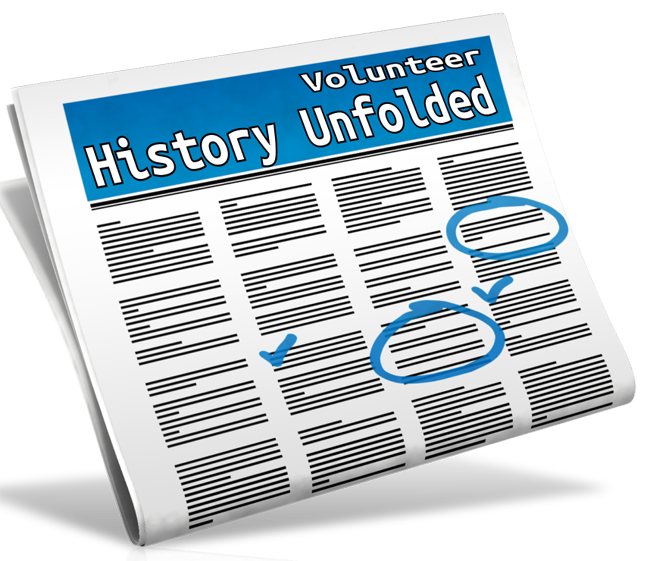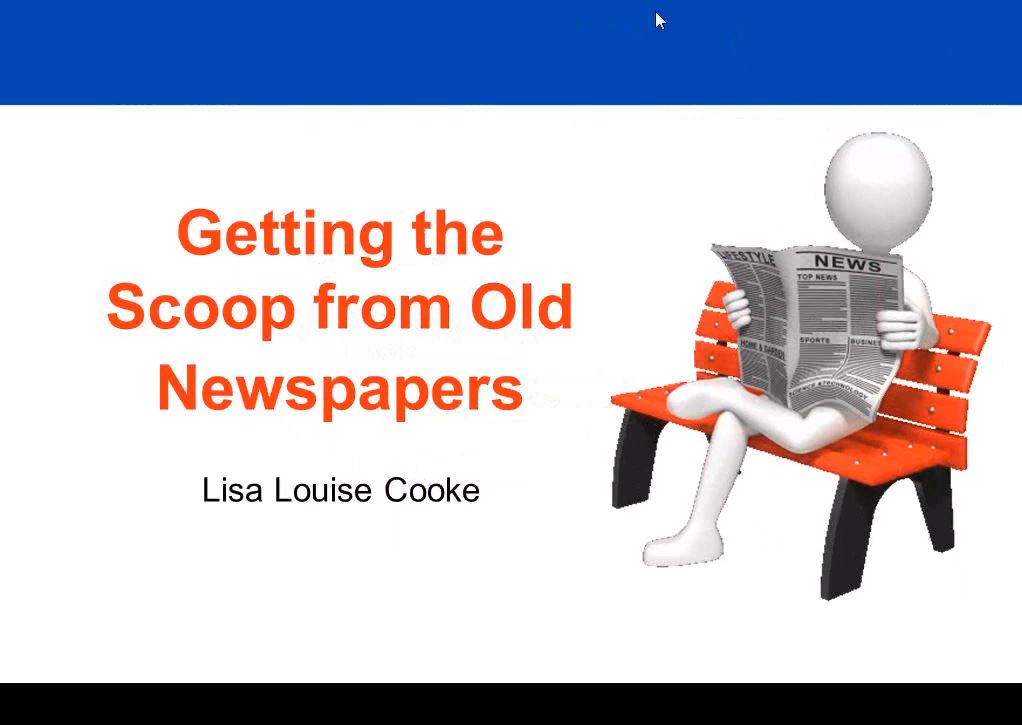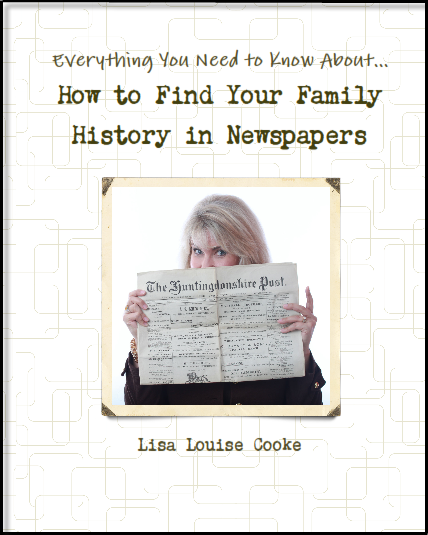by Lisa Cooke | Nov 4, 2013 | 01 What's New, Newspaper
Does your local library, historical or genealogical society have a newspaper collection to share? Let the NEH help!
The National Endowment for the Humanities (NEH) is accepting proposals from institutions hoping to participate in the the National Digital Newspaper Program (NDNP). This program creates “a national, digital resource of historically significant newspapers published between 1836 and 1922 in U.S. states and territories.” Guidelines for 2014 are now available and proposals must be submitted by January 15, 2014.
According to the press release, “Each award supports a 2-year project to digitally convert 100,000 newspaper pages from that state’s collections, primarily from microfilm negative. Titles may be printed in Danish, English, French, German, Hungarian, Italian, Norwegian, Portuguese, Spanish or Swedish. The program provides access to this resource through the Chronicling America web site hosted by the Library of Congress. The site currently includes more than 6.6 million newspaper pages in English, French, German, and Spanish, from more than 1100 titles digitized by institutions in 30 states.”
For more program information, please visit the NEH’s program page or this page for technical information from the Library of Congress. Click here to see what institutions have participated.
I can’t say enough good things about this and other initiatives to support more digitized newspapers online. My book How to Find Your Family History in Newspapers will provide you with more about using these awesome resources to flesh out your family’s story, a tried and true research process, and loads of resources. Check it out in paperback or pdf e-book!
by Lisa Cooke | Nov 29, 2013 | 01 What's New, Newspaper
Recently I did a webinar for Legacy Family Tree called “Get the Scoop on Your Ancestors with Newspapers.” Soon after, I heard from a happy student  named Christina.
named Christina.
“I just had to let you know how grateful I am to you,” she writes. “I finally had a chance to utilize the information you shared and wanted to check out the websites you talked about. I started with the Stanford Data Visualization and the very first newspaper I opened online had one of my ancestors on the front page. WOW! When I went into my Legacy program I discovered that I already had that information, but now I also had a verification.”
She goes on to say she started reading through more newspaper issues, which were so interesting she kept getting distracted. She found another ancestor mentioned in a political newspaper and guesses she’s just discovered his political affiliation.
Then she tells me about a longtime family mystery she decided to try to solve in newspapers. “My cousin’s daughter contacted me about a year ago for information about a child that died in the same time period that the local court records were lost in a fire. I didn’t think we would ever get the information. But I thought I would use the date that we had and start with any paper I could get online, starting the day after. I wasn’t sure it would hit papers that soon in that time period, but I had to start somewhere. Lo and behold, her death notice was on page 4 of the first paper I opened!”
“I realize I am very lucky to have found so much right away and it won’t happe

Available at http://genealogygems.com
n every time, but I am encouraged that your training was so helpful that I am going to break through a lot of walls. Again, Thank you so much for sharing your knowledge.”
I’ve heard countless stories like these from so many people who have discovered their family histories in newspapers. A video version of my newspaper class is available as part of Genealogy Gems Premium Membership, along with over a dozen other instructional videos, and over 100 exclusive podcast episodes. Starting today 11/29/13 through Monday 12/2/13 when you purchase a 1 year membership you will get an exclusive free ebook. Click here for all the details.
You can also get my complete newspaper research method in my book: How to Find Your Family History in Newspapers, available in print and as an e-book. And also starting today 11/29/13 through Monday 12/2/13 you can get it as part of a special book bundle or ebook bundle at a 40% savings.
by | Mar 5, 2014 | 01 What's New, Certification
 Do you want to become a professional genealogist–or just research like one?
Do you want to become a professional genealogist–or just research like one?
The Board for Certification of Genealogists (BCG) recently released an updated, revised version of Genealogy Standards in honor of its 50th anniversary. It’s a 100-page paperback manual that presents “the standards family historians use to obtain valid results.”
They also just announced that, effective March 3, 2014, the new BCG standards apply to anyone who applies for professional certification or recertification through BCG.
“As the standards are at heart unchanged, genealogists whose work meets the old standards should meet the new standards as well,” states a press release. “The revision, however, means the new standards offer superior guidance as to the qualities necessary for credible genealogical work.”
To help researchers familiarize themselves with the recent changes, BCG has also released two charts that compare the new and old standards. They can be downloaded from the “Skillbuilding” page of BCG’s website.
by Lisa Cooke | Jun 14, 2014 | 01 What's New, Organization
 Recently, Genealogy Gems podcast listener Debra Ingrum Trammel wrote to me with this question about cleaning out a relative’s home. Does it sound familiar?
Recently, Genealogy Gems podcast listener Debra Ingrum Trammel wrote to me with this question about cleaning out a relative’s home. Does it sound familiar?
“Hi Lisa, My husband is faced with the daunting task of disposing of his parent’s belongings. His parents at age 92 and 86 have things that go way back!!
We live in Tennessee and his parents lived in Texas so that in itself is a real chore to have to make numerous trips back and forth. My husband is so eager to get all of this finished but I am concerned that he will overlook or not be aware of any items that should be kept for his family history.
I continue to work on researching his side of the family. I know that we should keep certain documents: birth certificates, marriage licenses, definitely old photographs, etc. but I fear that there are items that I might not think about as being important. Might you offer some suggestions for us?
Here’s my answer:
Debra, I sympathize with your concern about overlooking things. When my Grandpa died I was pregnant with my last child and unable to go back and help clear out the house in another state. I worried too about things being tossed without folks realizing they were important.
One area to keep an eye out for is bills & receipts – a lot of folks (like my Grandmother) kept receipts from way back. While on the surface they seemed prime to toss, I was able to retrace their steps and homes through the 1940s and 1950s based on the addresses written on the receipts. What a delightful walk that was!
 Paperwork is often the area we itch to toss, but old envelopes and letters from other people writing to our relatives can provide many clues.
Paperwork is often the area we itch to toss, but old envelopes and letters from other people writing to our relatives can provide many clues.
I also carefully go through all old books before giving them away because more than once a special tidbit has been tucked inside the pages. If you don’t plan on keeping the book or don’t want to keep the item in the book, be sure to make note of which pages it was nestled in between. There could be a special meaning there. If everyone involved is in a big hurry to finish the cleanup and you don’t have the luxury of time to go through the pages of the books, at least give them a gentle shake over a table allowing anything tucked inside to fall out.
In Genealogy Gems Podcast episode 39 I tell the story of one of the most significant finds in my family that almost got tossed out. But Grandmother was tapping me on the shoulder, prodding me to look further before wrapping things up – and boy am I glad that I did! If folks in your family think you are being too persnickety about not overlooking things, play that segment of the show for them, or tell them the story.
These are just a few ideas to get you started. I invite all of you readers out there to share your unusual finds and recommendations for Debra on the Genealogy Gems Facebook page. (And don’t forget to “Like” us!)
We also have a large selection of free and Premium videos devoted to organizing and preserving family history items and information. Visit our Videos page and click the topic Organizing & Preserving. Each video includes a downloadable show notes cheat sheet.
Wishing you family history success, and many thanks for writing! Lisa
by Diahan Southard | Nov 4, 2014 | 01 What's New, Digital Archives, Military, Newspaper
If you research ancestors in the U.S., you’ve probably already used the Library of Congress’ Chronicling America website for searching digitized newspapers. Now they’ve added a new feature: you can subscribe to receive “old news” on many of your favorite historical topics!

The Evening World (New York, NY), Sept 10, 1900, Evening Edition, Page 2. Digitized image from Chronicling America.
Here’s how it works. You can sign up for weekly notifications that highlight interesting and newly-added content on topics that were widely covered in the U.S. press at the time. (Click here to see a list of topics.)
My favorite family history-related topics are natural disasters (like the Chicago fire or Galveston flood), war topics (from Appomattox to World War I) and civil and human rights events (from the Railroad Strike of 1886 to Ellis Island to coverage of Pullman porters). But there are a lot of topics that might relate to your family: industrialization (electric cars!), arts, sports (think Babe Ruth and the Boston Marathon), major crimes and trials, politics, holidays and public celebrations and public works and technology marvels (like the Panama Canal or Titanic).
To subscribe, just use the icons at the bottom of the Chronicling America home page.
Learn more about finding your ancestors in the newspaper in Lisa’s book, How to Find Your Family History in Newspapers. She walks you through the process of determining which newspapers might mention your ancestors and where to find those papers (both online and offline). You’ll learn in detail about Chronicling America and more about other free and subscription options for searching online newspapers. Best of all, Lisa shares mouthwatering examples from her own research that show you why newspapers can be such a valuable source of information on our family history.


 named Christina.
named Christina.



